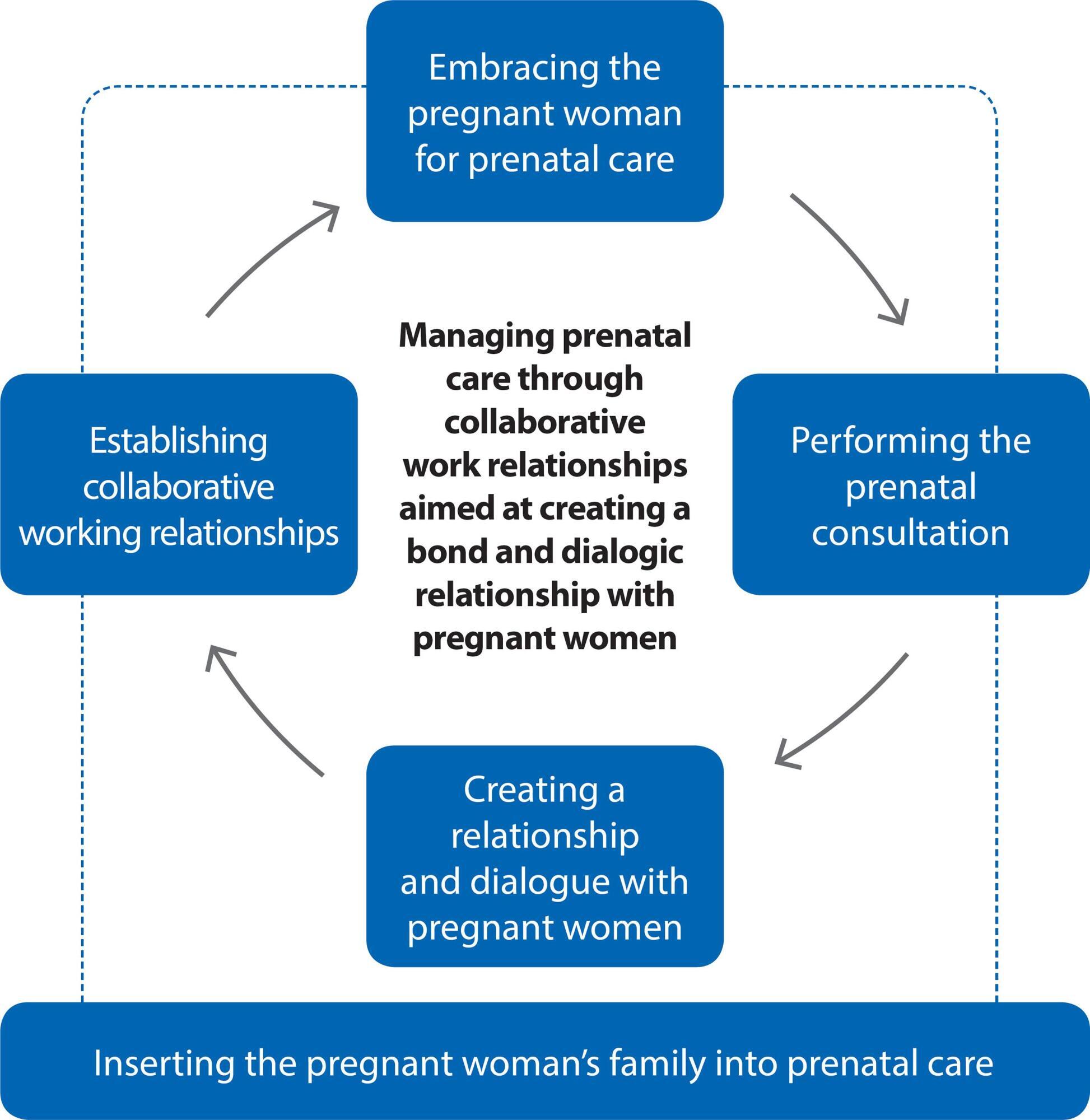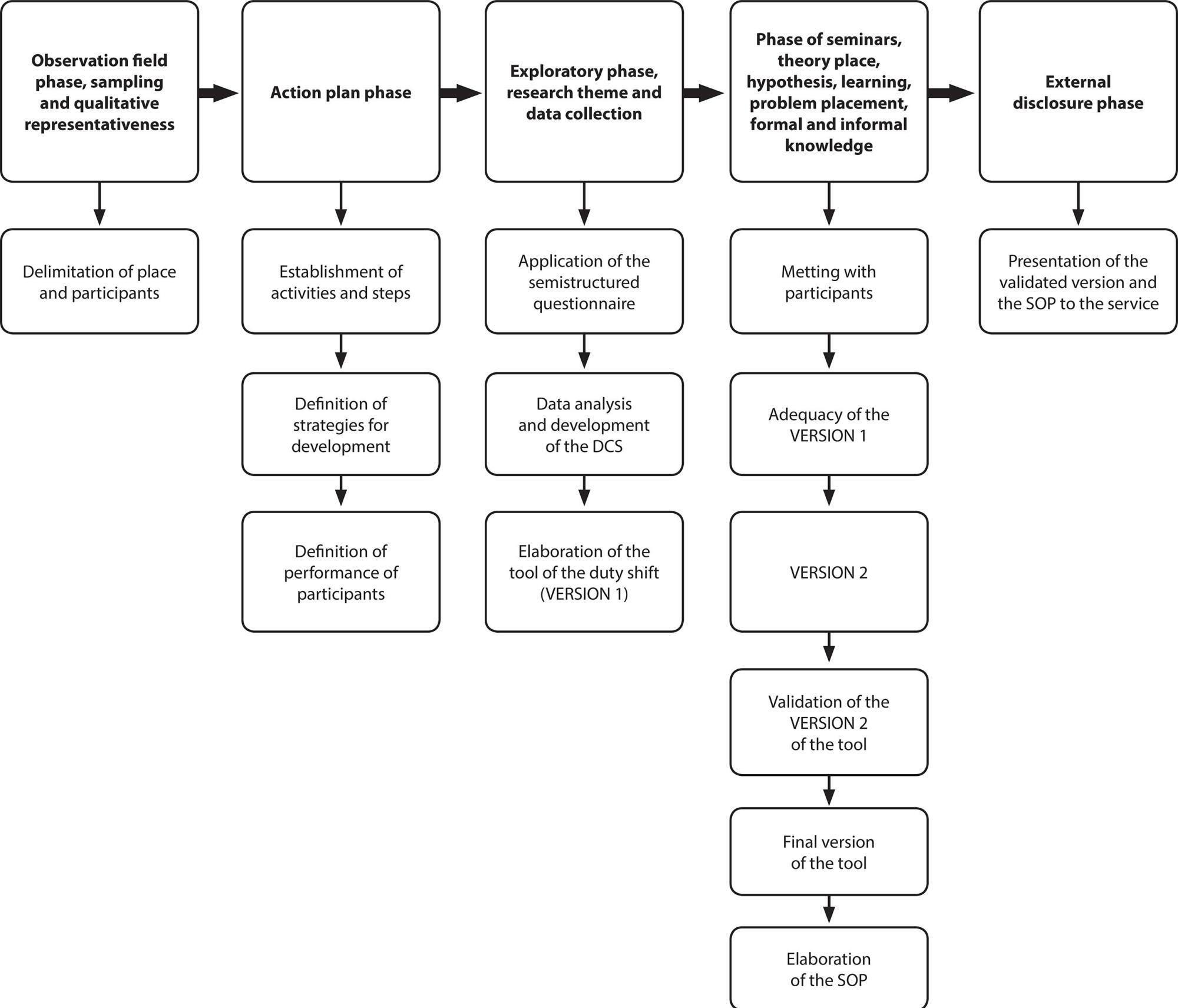-
ARTÍCULO ORIGINAL01/02/2019
Management of prenatal nursing care at a Health Center in Angola
Revista Brasileira de Enfermagem. 2019;72:129-136
Resumen
ARTÍCULO ORIGINALManagement of prenatal nursing care at a Health Center in Angola
Revista Brasileira de Enfermagem. 2019;72:129-136
DOI 10.1590/0034-7167-2017-0685
Visualizações0Ver maisABSTRACT
Objective:
To understand how care management in prenatal care in a Care Center in Angola happens.
Method:
A qualitative study, which used the Constructivist Grounded Theory (GT) as a methodological framework. The theoretical sample consisted of 22 participants, including nursing professionals, pregnant women and nursing students from Huambo, Angola. The data were collected by interviews and analyzed according to initial and focused coding.
Results:
Five categories arose: Embracing the pregnant woman for prenatal care; Performing the prenatal consultation; Creating a bond and dialogical relationship with pregnant women; Establishing collaborative working relationships; and Inserting the pregnant woman’s family into prenatal care.
Conclusion:
The management of nursing care in the study setting is effective through complementary and interdependent steps, based on collaborative relationships among professionals and in the effort to establish bonds with pregnant women and their families.

-
ARTÍCULO ORIGINAL01/02/2019
Epidemiological profile of farmworkers from the state of Rio de Janeiro
Revista Brasileira de Enfermagem. 2019;72:122-128
Resumen
ARTÍCULO ORIGINALEpidemiological profile of farmworkers from the state of Rio de Janeiro
Revista Brasileira de Enfermagem. 2019;72:122-128
DOI 10.1590/0034-7167-2017-0555
Visualizações0Ver maisABSTRACT
Objective:
to describe the epidemiological profile of farmworkers exposed to pesticides in the city of Casimiro de Abreu, Rio de Janeiro State.
Method:
cross-sectional study, conducted through a questionnaire. The collected data were typed in spreadsheet and processed in the R software.
Results:
the predominance of female participants, between 40 and 60 years old, married, with some elementary education was observed. Furthermore, the family labor and the production for their own consumption and trade prevail. Herbicide is the most widely used pesticide. Most informants present poisoning symptoms, as they do not use Personal Protective Equipment nor sunscreen. Breast cancer is the most frequent in families; among the participants, 31% had hypertension and 6.4% diabetes.
Conclusion:
a population vulnerable to environmental and occupational risks, specially the middle-aged group and women, sets up a profile marked by regional differences.
-
ARTÍCULO ORIGINAL01/02/2019
Expansion of the interprofessional clinical practice of Primary Care nurses
Revista Brasileira de Enfermagem. 2019;72:114-121
Resumen
ARTÍCULO ORIGINALExpansion of the interprofessional clinical practice of Primary Care nurses
Revista Brasileira de Enfermagem. 2019;72:114-121
DOI 10.1590/0034-7167-2017-0759
Visualizações0Ver maisABSTRACT
Objective:
To analyze the clinical practice of nurses in the interprofessional context of the Family Health Strategy.
Method:
Case study in a basic health unit of the city of São Paulo with a professional team of the Family Health Strategy and of the Family Health Support Center. Direct observation and interviews with thematic analysis and triangulation were conducted.
Results:
Four empirical categories were identified: interprofessional actions guided by the logic of the user’s health needs; interprofessional actions guided by the logic of expediting service; interprofessional actions with a biomedical approach and interprofessional actions with an integral/holistic approach. Six interprofessional actions that indicated the expansion of the clinical practice of the Family Health Strategy’s nurses were also identified.
Conclusion:
The results express the world trend of interprofessional practice and expansion of the scope of practice of different professions, particularly that of nurses, which requires consolidation based on the population’s health needs.
-
ARTÍCULO ORIGINAL01/02/2019
Training of intensive care nurses to handle continuous hemodialysis: a latent condition for safety
Revista Brasileira de Enfermagem. 2019;72:105-113
Resumen
ARTÍCULO ORIGINALTraining of intensive care nurses to handle continuous hemodialysis: a latent condition for safety
Revista Brasileira de Enfermagem. 2019;72:105-113
DOI 10.1590/0034-7167-2018-0013
Visualizações0Ver maisABSTRACT
Objective:
To analyze the repercussions of the training of nurses working in the Intensive Care Unit for the management of continuous hemodialysis regarding the safety of critical patients with acute renal failure.
Method:
Qualitative research developed considering James Reason’s reference in the Intensive Care Unit of a private hospital. The data was collected with 23 nurses who worked for more than three months in the management of continuous hemodialysis through a semi-structured interview, and analyzed with the thematic content analysis technique.
Results:
There are weaknesses in the training of intensive care nurses for the management of continuous hemodialysis that become a latent failure. Such a failure results in difficulties in handling hemodialysis, with risks for these professionals to commit active failures.
Final considerations:
The training program in service for the management of continuous hemodialysis must be perfected, to develop skills and competencies in nurses and improve their performance.
-
ARTÍCULO ORIGINAL01/02/2019
Presenteeism in multiprofessional team workers in the Adult Intensive Care Unit
Revista Brasileira de Enfermagem. 2019;72:96-104
Resumen
ARTÍCULO ORIGINALPresenteeism in multiprofessional team workers in the Adult Intensive Care Unit
Revista Brasileira de Enfermagem. 2019;72:96-104
DOI 10.1590/0034-7167-2017-0779
Visualizações0Ver maisABSTRACT
Objective:
To analyze the occurrence of presenteeism in multiprofessional team workers of an Adult Intensive Care Unit, relating it to sociodemographic and labor characteristics.
Method:
It is an analytical cross-sectional qualitative study, which used a questionnaire for sociodemographic data collection, and Stanford Presenteeism Scale(SPS-6) to assess presenteeism.
Results:
There was predominance of women (75.9%), nursing workers (66.7%), mean age of 39.81 years, and 6 to 10 years (31.6%) of experience in the labor market. Regarding presenteeism, 48.7% presented work impairment and 31.8% presentedperformance and completion of tasks altered by this phenomenon.
Conclusion:
Expressive numbers of general presenteeism were identified, with results indicating impairment in completing work. When connecting presenteeism to sociodemographic and labor characteristics, the variables sex, dependent children and absence from work presented values with statistical significance among the studied workers.
-
ARTÍCULO ORIGINAL01/02/2019
Standardization of the duty shift in a General Adult Intensive Care Unit
Revista Brasileira de Enfermagem. 2019;72:88-95
Resumen
ARTÍCULO ORIGINALStandardization of the duty shift in a General Adult Intensive Care Unit
Revista Brasileira de Enfermagem. 2019;72:88-95
DOI 10.1590/0034-7167-2017-0745
Visualizações0Ver maisABSTRACT
Objective:
To standardize the duty shift in a General Adult Intensive Care Unit.
Method:
Multi-method research, which used action research, descriptive study and content validation. Participants included 11 care nurses and 4 intensive care nurses. For the data collection, a semi-structured questionnaire was used, meetings with participants and validation with specialists. In this step, the modified online Delphi Technique was used. For data treatment, the Discourse of the Collective Subject (DCS) was used, descriptive analysis and Content Validity Index.
Results:
Three DCS on duty change, a Standard Operating Procedure (SOP) and an information registration instrument, validated in appearance, clarity, suitability and content.
Final considerations:
The instrument assists in the transmission of information, strengthening patient safety and SOP will outline the shift, these tools can improve ICU shift, minimizing the risks of communication failure.

-
ARTÍCULO ORIGINAL01/02/2019
Care model for Primary Care workers: Convergent Care Research
Revista Brasileira de Enfermagem. 2019;72:80-87
Resumen
ARTÍCULO ORIGINALCare model for Primary Care workers: Convergent Care Research
Revista Brasileira de Enfermagem. 2019;72:80-87
DOI 10.1590/0034-7167-2017-0625
Visualizações0Ver maisABSTRACT
Objective:
To verify the application of the Operative Group as a care tool for the workers of Primary Health Care, with a view to the constitution of mental health care at work.
Method:
Convergent Care Research as a research process and health workers as subjects. The intervention strategy as a proposal to accommodate the mental suffering of the worker was the Operative Group.
Results:
Two categories emerged: «Evidence of Suffering at Work» and «Group Learning: Group Reception by the Group».
Final considerations:
The use of the Operative Group has been assertive in providing the subjects with a space for listening to adversities in the work environment and active learning of reality, reflection and confrontation of basic fears, development of a pro-change project through peer and active learning of reality.
-
ARTÍCULO ORIGINAL01/02/2019
Interactionist view of circumstances that interfere with nurses’ lifestyle
Revista Brasileira de Enfermagem. 2019;72:74-79
Resumen
ARTÍCULO ORIGINALInteractionist view of circumstances that interfere with nurses’ lifestyle
Revista Brasileira de Enfermagem. 2019;72:74-79
DOI 10.1590/0034-7167-2017-0062
Visualizações0Ver maisABSTRACT
Objective:
To analyze the circumstances interfering with nurses’ lifestyle.
Method:
Qualitative study in light of the premises of the Grounded Theory and with theoretical reference of the Symbolic Interactionism. The study was conducted with 20 nurses from the municipality of Pinheiral, state of Rio de Janeiro.
Results:
The interference of work in nurses’ lifestyle was unanimous and expressed by the union of the following subcategories: blaming work for sedentary habits; recording the lack of time; justifying physical/mental fatigue by the lack of healthy habits; emphasizing the financial situation; and exchanging self-care for the care of the other.
Final considerations:
The results showed nurses’ complex life, as well as new possibilities for conducting daily choices. The need for actions that reduce the impact of workdays and contribute to these professionals incorporating a better lifestyle is noteworthy.
Búsqueda
Buscar en:
Nuvem de Tags
Adolescente (85) Atenção Primária à Saúde (239) COVID-19 (91) Criança (91) Cuidados de Enfermagem (269) Educação em Enfermagem (151) Educação em Saúde (139) Enfermagem (930) Enfermagem Pediátrica (86) Estudantes de Enfermagem (77) Estudos de Validação (131) Família (87) Idoso (208) Promoção da Saúde (99) Qualidade de Vida (104) Saúde do Trabalhador (86) Saúde Mental (145) Saúde Pública (82) Segurança do Paciente (150) Tecnologia Educacional (100)



